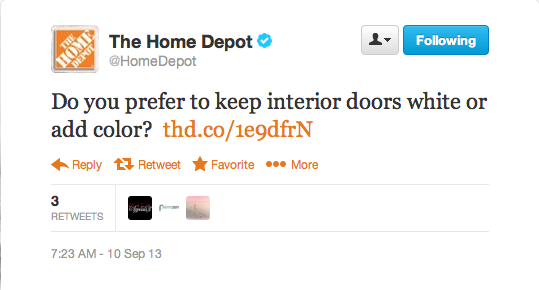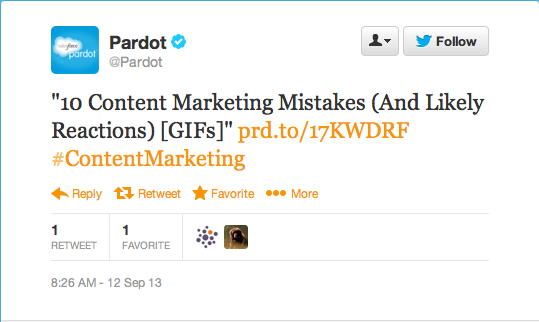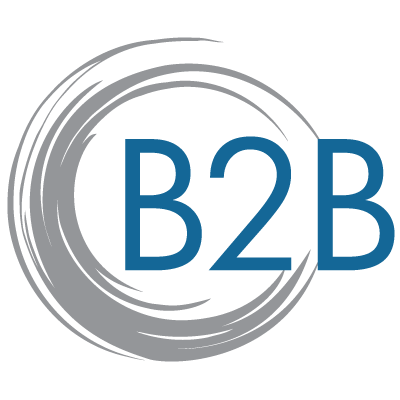by gabriel_sales | Sep 11, 2013
 Since Twitter came on the social media scene in 2006, it has become extremely embedded into both our personal and professional communication. News articles and television programs now constantly reference tweets as a part of their stories. What you say on Twitter can now end your career or make you a million dollars.
Since Twitter came on the social media scene in 2006, it has become extremely embedded into both our personal and professional communication. News articles and television programs now constantly reference tweets as a part of their stories. What you say on Twitter can now end your career or make you a million dollars.
What is interesting about Twitter is that it has blurred the lines between personal social interaction and commercial discourse. The informal and conversational nature of Twitter allowed businesses to talk to consumers and for consumers to talk back in a way that is much more authentic and transparent than ever before.
For B2B companies, this means Twitter can be an effective communication tool as well as an effective social media marketing strategy. Here are several tips for how to communicate effectively and increase engagement with your tweets:
3 Ways to Use Twitter More Effectively for B2B Marketing
- Get your audience involved in your story.
Twitter is a place for interaction and dialogue, so you need to facilitate the conversation between your brand and your followers. You can do this by asking questions, requesting opinions or posting links to online polls. When your followers engage with you by responding to your questions or retweeting your content, make sure you recognize them for doing so. Thank people when they give you valuable insight and respond quickly when people ask questions of their own.

- Stay on top of what’s happening in the news.
Twitter is about what’s happening now, not what happened five minutes ago. Therefore, your tweets will be much more engaging if they are related to what’s happening in the present moment. That doesn’t mean you should be tweeting about things unrelated to your business; it means you should share any news relevant to what you do with your followers. Bonus points if you can take news unrelated to your business and make it so, like Taco Bell did here:

- Aim for being valuable, rather than going viral.
In the world of B2B sales, it is going to take something truly exceptional for a tweet to go viral. News about software startups and management consulting services just isn’t as sexy as that Kardashian sister’s latest scandal, and it never will be. Don’t try to keep up with the Kardashians. Just try to connect with your followers by offering them value. Give them industry tips and statistics, share educational blog articles, informative webcasts, etc. The more you give to your followers, the more they will give back. If you can offer enough value, your followers will not only become customers, but they will tweet your praises to the rest of the Twitterverse—something most marketers dream of constantly. In the example below, Pardot offers value and entertains simultaneously–the sweet spot we should all be aiming for.

For more on how to use twitter more effectively for B2B marketing, click here. If you have any questions, please feel free to contact us.

by gabriel_sales | Sep 9, 2013
How B2b marketing leads to more profitable outcomes
As a sales and marketing outsourcing company with over 13 years of experience, we have executed countless email marketing campaigns for both ourselves and our clients. During those years, we have learned what works and what doesn’t in terms of B2B lead generation and conversion.
Here are 3 tips to improve your email lead generation:
- Offer value and make it highly visible.
The key to using email to turn prospects into leads is offering value. For B2B products and services, the value offered is usually some form of content. This is known as email content marketing. The content you send can vary greatly, but should generally be educational in tone. You can send short blog articles, important industry news, webinar invitations, video links, industry reports, white papers, etc. By sending your prospects content that has some type of value for them, they start to think of you as an expert in your field and will eventually turn to you when they are ready to make a purchase.
When offering value in your B2B marketing emails, make sure it is the focal point of the entire message. People love getting gifts, and that is essentially what you are doing by offering your content. Make this obvious, and your prospects will thank you in the form of conversion.
2. Think about how emails are viewed.
Think about your own inbox. It is likely that when you open many of your emails, a notice appears telling you the certain images have been blocked. Most email applications (including Outlook) now have the default setting to not display images, so you need to think about this when crafting your marketing emails. Make sure any information that is critical does not appear exclusively in an image.
It is also helpful to think about the display window you view your emails in. For most of us, we view our emails in a preview window, and therefore only see a small portion of the message at a time. Many people only scan the first line of an email before deciding whether or not to delete it, and if your prospect does not see anything of value immediately, you might end up in the trash. Make sure that the value you are offering in your email (whether it is an announcement about a sale, an educational webcast, a new blog post, etc.) is immediately obvious and is visible within the small preview frame of most email applications.
3. Analyze and refine constantly.
Once you have created your email for lead generation, make sure it stands out. Open it up and compare it side by side with your competitors’ emails that have similar goals or calls to action. Are your graphics sharp enough or do they look dated in comparison? Is your overall messaging aligned with theirs? Is your differentiator clear and immediately obvious? What is it about your email that makes it better than all of the others? If you don’t know, it is time to back to the drawing board.
If you would like more information on email lead generation or using email for B2B marketing, click here. If you would like to know more about content marketing in relation to the new rules of buying and selling in the digital era, you can download our white paper here.
If you have any questions, please feel free to contact us.
by gabriel_sales | Aug 15, 2013
 Building landing pages that convert is both a science and an art. You need to present information in a logical way with a visually inviting format—without selling too hard. Note easy, but not impossible either.
Building landing pages that convert is both a science and an art. You need to present information in a logical way with a visually inviting format—without selling too hard. Note easy, but not impossible either.
Here are 5 Tips for Landing Page Conversion Success:
- Get rid of the “Submit” button.
I know that the word “submit” is a clear denotation for what is happening when someone fills out a form on a landing page but tell me, what’s exciting about “submitting” anything? Ever? Nothing. So, don’t put it on your landing page forms.
Make your form button a place where you restate the value of what your prospects are getting when they fill out your form, i.e. “Get My White Paper Now” or “Send Me More Information”. Like Amazon’s “Buy with 1-Click” button, reminding people of what they are getting out of the transaction makes them much more likely to actually click.
2. Remove extraneous links.
With a homepage on a website, having a navigation bar along the top and links to recent blog posts along the side is probably a good idea. You want people to be able to find a wide range of information with ease. Your goal for landing pages should be different; a good rule of thumb is ‘one goal for one landing page’.
This means having a complex navigation bar and links on the side or in the text is a distraction from your overall goal. If your goal is to get people to sign up for a webinar, make that the only action available to them on the page and take away all other navigation. If your goal is to offer educational content, you can offer it in various mediums, just don’t also put a link for a webinar invite alongside your content offers.
3. State the value in the headline.
Headlines on landing pages are extremely important. The headline is usually the first thing the eye sees when they come to your landing page, so it needs to grab attention. Make the headline the place where you make the value of your landing page offer glaringly obvious. For example, use “5 Easy Steps to Build Your Own Lead Generation System” rather than “Download Our New Lead Generation White Paper”. The clearer you can make the value, the closer you are to having landing pages that convert.
4. Say less.
While you do want to make sure that the value you are offering is clearly stated, it does not need to be overstated. When describing your landing page offer, it is usually a good idea to offer short sentences and bullet points.
When people come to a landing page, they want to quickly determine whether or not to leave. While it is easy to quickly scan through bullet points, reading through long paragraphs takes time, and if I can’t find the information I want in ten seconds or less, I’m gone. If you need to explain your offer in sentences that’s fine, just use very short paragraphs and italics or bold for emphasis.
5. Make the form “pop”.
Landing pages should be highly visual, and it’s great to use graphics and pictures to grab attention and help tell a story. That being stated, you want to make sure that your visuals don’t distract from your overall goal: building landing pages that convert. To do this, make sure your landing page form stands out and is visually inviting. This can be done easily by making the form a different color, giving it a 3-D shadow, or changing the font.
If you would like more information on landing pages, you can read more educational blogs by clicking here. If you have any questions, please feel free to contact us.
by gabriel_sales | Aug 5, 2013
 In the past, the buyer’s road to a B2B purchase was pretty clear. As there weren’t many options for gathering information on products and services, buyers had to go to trade shows or read through industry catalogues if they were looking for a solution. Information was so scarce that these buyers didn’t mind being “sold to”, either directly or through marketing messages.
In the past, the buyer’s road to a B2B purchase was pretty clear. As there weren’t many options for gathering information on products and services, buyers had to go to trade shows or read through industry catalogues if they were looking for a solution. Information was so scarce that these buyers didn’t mind being “sold to”, either directly or through marketing messages.
Today, we are all on information overload. An article in Huffington Post estimates that Americans are exposed to 250 to 3,000 advertising messages daily. Buyers today are not hungry for sales information; they want to get as far away from it as they can.
This is the situation that has added tremendous value to B2B inbound marketing techniques, especially for lead generation. Because so many buyers are now turned off by traditional, self-promotional marketing, less intrusive inbound strategies instead let the buyer come to you when they are ready to be sold to.
In fact, all of your B2B inbound marketing tactics should not be focused on closing, but instead focused on education and giving prospects the information they need to move themselves through your sales cycle independently. This means that when coming up with an inbound marketing strategy, you need to map out your sales cycle and create educational marketing content to fit each stage.
Inbound marketing content can vary immensely, depending on your company’s needs and overall goals. Blogs, quick YouTube videos and infographics are great for early stage buyers while white papers, software demos or comparison-focused content are better later in the buying cycle. Social media can be used throughout the buying cycle and is great for lead nurturing and staying top of mind.
While all of these inbound marketing strategies can be effective for B2B lead generation, it is extremely difficult to measure that effectiveness without a marketing automation platform in place. With marketing automation, you have a “behind-the-scenes” view of which prospects are interacting with what content. You are therefore able to identify where your leads are coming from and how far along in their buying stage they are. You can also determine what tactics are most successful by measuring how many leads are coming from each source or piece of content.
If you would like more information on B2B inbound marketing tactics, click here. If you have any questions, please feel free to contact us.
by gabriel_sales | Aug 2, 2013
Marketing Profs just released the results of a survey of B2B marketing professionals that discusses their biggest challenges. The survey found that the biggest challenge for B2B marketers is generating more leads.
While lead generation can be more difficult in the B2B space than in others, it does not have to be mystifying or impossible. As a sales and marketing outsourcing company with over 13 years of experience selling B2B products and services, here are three effective methods we have found for how to generate B2B sales leads:
- Outbound email marketing
Outbound email marketing may be one of the more traditional ways to generate B2B sales leads, but people wouldn’t keep doing the same thing if is didn’t work. Sending out introductory emails that emphasize the problem you can solve is always going to catch the eye of someone who desperately needs help. As long as you keep the emails educational in tone and keep out the sales-language, prospects have every reason to give you a chance and find out what you’re about. If you do a good enough job presenting your value with an intriguing call-to-action, you will have new leads.
2.  Long-tail SEO
Long-tail SEO
The success of long-tail search keywords is now well known in the worlds of digital buying and selling, and the value of this method is only going to increase as time goes on. By optimizing your website and all of your digital marketing content for long-tail, rather than short/thick-tail keywords, you have less competition and can find your niche market in a strategic way. The increased use of using voice commands like Apple’s “Siri” or “Google Voice”means that more and more people are going to be speaking their search queries, which will therefore will be longer, as they are unhindered by the effort of typing. For example, when you ask Siri for the weather, you are more likely to say ”What’s the weather going to be like in Denver today?” than “Denver weather.” Bottom line: long-tail is here to stay.
3. Telemarketing with educational content offers
While this may sound surprising, telemarketing is still one of the best ways to generate B2B sales leads. Yes, cold calls are declining in effectiveness, but that does not mean people don’t want to talk to you. In order to make telemarketing effective in 2013, you have to offer your prospects something of value. Whether it be an blog article, a white paper, a YouTube video doesn’t matter—it just needs to be educational and valuable to the type of customer you are targeting.
We think these three methods for how to generate B2B sales are each effective on their own. However, when you integrate all three of these methods and leverage a marketing automation system alongside it, the results are tenfold. To learn about the benefits of marketing automation, click here.
If you have any questions about how to generate B2B sales leads or would like to talk to a sales outsourcing representative about lead generation services, click here.
by gabriel_sales | Jul 26, 2013
 The fast-paced nature of today’s B2B sales world has some marketer’s heads spinning trying to figure out the best ways to find and qualify b2b sales leads. Tips, trends and industry reports all say the same thing in regards to inbound B2B lead gen: B2B content marketing is king and you need to post content constantly.
The fast-paced nature of today’s B2B sales world has some marketer’s heads spinning trying to figure out the best ways to find and qualify b2b sales leads. Tips, trends and industry reports all say the same thing in regards to inbound B2B lead gen: B2B content marketing is king and you need to post content constantly.
Most successful marketers are already doing this. But, we all want more leads.
Here are 3 seemingly insignificant things you might be doing that are costing you leads:
- You content isn’t mobile-friendly.
53% of Americans now own smartphones and time spent on mobile devices is growing. A lot of B2B clients scroll through their social media feeds on their phone while their kids are at soccer practice or read blogs on their iPad in bed. If your content isn’t compatible on mobile devices, you are essentially giving these customers to your competition.
2. Your CEO/Executives are silent on social media.
82% of companies say they trust a company more when the CEO and/or executive team communicate via social media. This means that if you’ve hired a copywriter or social media manager to create all of your social media content, you might be losing credibility. People looking to make a B2B purchase want to know about the people they will be buying from or working with. By having your CEO tweet or write a blog article every now and then, you can make your company seem more human and trustworthy. You can even copy the way Obama does it. He has someone else posting the majority of his tweets, but when one comes from him directly, he signs it “-bo.”
3. You aren’t using hashtags on Facebook.
A year ago, using hashtags on Facebook would likely make you the brunt of some social-media-savvy jokes. However in June 2013, Facebook incorporated hashtags into their system, and you can now use hashtags to help you classify information with short keywords. Your B2B prospects can also find you by searching particular hashtags, just like on Twitter. This means that if you aren’t hashtagging on Facebook and Twitter and LinkedIn, you aren’t doing everything you can to find new leads using social media.
For more information on B2B sales lead gen or how to improve sales, download our white paper on “The New Rules of Seilling & Buying in 2013” here. If you have any questions, please feel free to contact us.
 Since Twitter came on the social media scene in 2006, it has become extremely embedded into both our personal and professional communication. News articles and television programs now constantly reference tweets as a part of their stories. What you say on Twitter can now end your career or make you a million dollars.
Since Twitter came on the social media scene in 2006, it has become extremely embedded into both our personal and professional communication. News articles and television programs now constantly reference tweets as a part of their stories. What you say on Twitter can now end your career or make you a million dollars.








 The fast-paced nature of today’s B2B sales world has some marketer’s heads spinning trying to figure out the best ways to find and qualify b2b sales leads. Tips, trends and industry reports all say the same thing in regards to inbound B2B lead gen: B2B content marketing is king and you need to post content constantly.
The fast-paced nature of today’s B2B sales world has some marketer’s heads spinning trying to figure out the best ways to find and qualify b2b sales leads. Tips, trends and industry reports all say the same thing in regards to inbound B2B lead gen: B2B content marketing is king and you need to post content constantly.